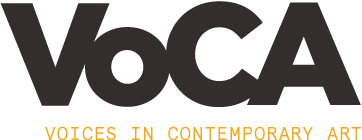Editor’s Note
In this issue of VoCA Journal, we bring together voices from many corners of the art world to discuss access and the arts. Access is best thought of as a shared responsibility; my hope is that this issue provides tools, precedents, and examples that can guide us all to bring access to the work we do.
Watching the art world celebrate the work of disabled artists and confront accessibility issues in the past couple of years has been both heartening and concerning. We’re all learning, and I’ll be the first to admit that I’ve made mistakes when it comes to access. Access is never perfect or complete: there can never be some fool-proof anticipation of everybody’s every need, nor do ex post facto translations from one media into another—be they sounds into captions or images into descriptions—work as flawless facsimiles. But it’s frustrating to see some institutions celebrate the work of disabled artists without taking their messages to heart. Disability culture is gaining increased recognition, but the art world remains far from accessible.
I hope that we won’t soon forget the lessons that many of us have learned about remote access during the pandemic: that we can be flexible and accommodating, that health and safety are priorities, and that there are plenty of alternative ways to get together. Heeding the wisdom of disability justice and disability culture means radically upending the art world’s habits and norms. That’s why we are bringing together voices from many corners of the field to discuss access and the arts for this issue of VoCA Journal. Access is best thought of as a shared responsibility, though usually it winds up being foisted onto museum educators alone. It’s commonly added on at the end in “special,” segregated programs rather than incorporated into the artist’s vision from the get-go, or taken seriously by curators. I hope that this issue will provide tools, precedents, and examples that can guide us all to bring access to the work we do.
Two artists in this issue recount personal experiences being unable to access art. Joseph Grigely collected and compiled numerous apologies from event organizers who failed to provide the closed captions he relies on at online events. They’re simply infuriating, and also very revealing. We’ve attached a few resources for event captioning to his essay. Panteha Abareshi recalls a number of inaccessible artworks involving staircases that they encountered in Los Angeles museums, detailing how these experiences catalyzed their own artistic practice. Likening analog media’s beautiful defunct-ness to that of disability, Abareshi also makes work that they themselves cannot access, exploring what it means for something to be out of reach. Elizabeth Guffey reflects on her experience teaching a course called the Inclusive Museum at SUNY Purchase. Her essay takes readers through a crash course in museum accessibility and serves as a pedagogical example.
The articles in this issue consider not only how to make art itself accessible, but art professions as well. In a roundtable, conservators Joelle Wickens, Sally Gunhee Kim, and Sarah Scaturro ask how to make their field more equitable while also discussing the unique contributions that disability brings to conserving artworks. Program Coordinator Natalie Sandstrom considers the impact of the Americans with Disabilities Act (ADA) on her work at the ICA Philadelphia, encouraging museums to go beyond the ADA’s building code requirements to make programs inclusive, too—by, for instance, hiring American Sign Language (ASL) interpreters for curatorial talks. And I had the great joy of interviewing Victor Cole, who describes artworks, plays, and movies to blind and low vision people for a living. I wanted to hear an expert’s opinion on how artworks can and should be described.
Whether architectural or audiovisual, on-stage or behind-the-scenes, we all have a role to play in making the future accessible. I’m excited to share with you the voices of the people leading the way.
—Emily Watlington


